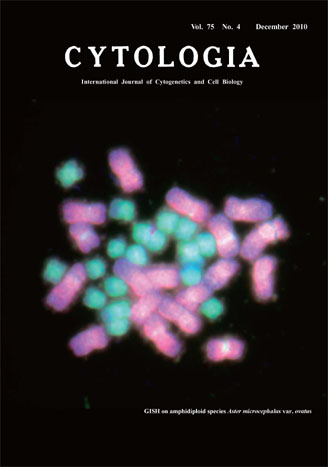| ON THE COVER |  |
|---|---|
| Vol. 75 No.4 December 2010 | |
| Technical note | |
|
|
|
| GISH on mitotic metaphase of amphidiploid
species Aster microcephalus var. ovatus R Genomic in situ hybridization (GISH) has been used to solve the presence of alien genomes,chromosome rearrangements, and taxonomic problems. In particular, this technique allows the discrimination of parental genomes in natural alloploid species. The image shows GISH on mitotic metaphase of amphidiploid species Aster microcephalus var. ovatus (2n=36). To detect parental origin and the genome composition, GISH using genomic DNA probes from A. iinumae (=Kalimeris pinnatifida) (2n=18) and Aster ageratoides (2n=18) was carried out (see Matoba et al. 2007. J. Plant Res. 120: 585–593). For slide preparation of chromosome, fine root tips of living plants of A. microcephalus var. ovatus were collected, and were pretreated with 2 mM 8-hydroxyquinoline at room temperature for 3 h before being fixed in ethanol acetic acid (3 : 1) at 4°C for 24 h. Chromosomal preparations were prepared using air-dried method. Fixed root tips were washed 3 times in distilled water, then 10–30 root tips were placed in a microcentrifuge tube containing 500m l of enzyme solution (1% Cellulase Onozuka-RS and 0.5% Pectolyase Y-23, pH 4.2) and incubated at 37°C for 1 h. They were washed 3 times with distilled water before 10–20m l of the fixative was dropped onto them and air-dried. To obtain genomic probes, total genomic DNAs of A. ageratoides and A. iinumae was extracted from young growing leaves. The genomic DNA of A. iinumae and A. ageratoides were labeled with biotin-16-dUTP using Biotin-High Prime and DIG-11- dUTP using Dig-High Prime, respectively. The labeled genomic DNA probes of A. iinumae and A. ageratoides were detected by FITC (green) and rhodamine (red), respecively. The slides were then mounted in Vectashield Mounting Medium containing 500 ng/ml of 4,6-diamidino-2-phenylindole (DAPI) for counter staining (blue). (Hideyuki Matoba1,2, Akiko Soejima3 and Yoshikazu Hoshi4: 1Japan Wildlife Research Center, 3–10–10 Taitou- ku Shitaya, Tokyo, 110–8676, Japan; 2Department of Applied Biological Science, College of Bioresource Sciences, Nihon University, 1866 Kameino, Fujisawa, 252–8510, Japan; 3Department of Biological Science, Graduate School of Science and Technology, Kumamoto University, Kurokami, Kumamoto 860–8555, Japan; 4Department of Plant Science, School of Agriculture, Tokai University, Kawayo, Minamiaso-mura, Aso-gun, Kumamoto 869–1404, Japan) |
|
l |
|